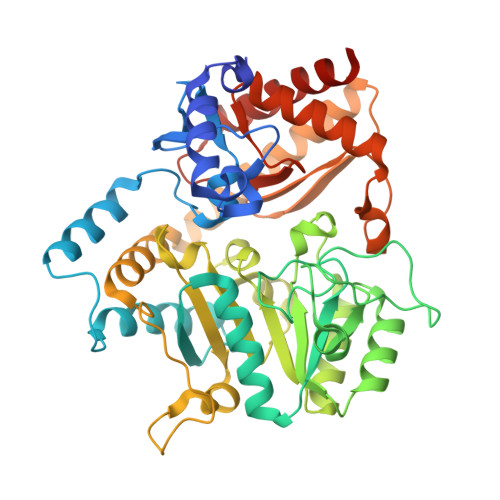Structural insights into the enzyme specificity of a novel omega-transaminase from the thermophilic bacterium Sphaerobacter thermophilus.
Kwon, S., Lee, J.H., Kim, C.M., Ha, H.J., Lee, S.H., Lee, C.S., Jeon, J.H., So, I., Park, H.H.(2019) J Struct Biol 208: 107395-107395
- PubMed: 31560999
- DOI: https://doi.org/10.1016/j.jsb.2019.09.012
- Primary Citation of Related Structures:
6K8H - PubMed Abstract:
Transaminases are pyridoxal 5'-phosphate-dependent enzymes that reversibly catalyze transamination reactions from an amino group donor substrate to an amino group acceptor substrate. ω-Transaminases (ωTAs) utilize compounds with an amino group not at α-carbon position as their amino group donor substrates. Recently, a novel ωTA with broad substrate specificity and high thermostability from the thermophilic bacterium Sphaerobacter thermophilus (St-ωTA) has been reported. Although St-ωTA has been biochemically characterized, little is known about its determinants of substrate specificity. In the present study, we determined the crystal structure of St-ωTA at 1.9 Å resolution to clarify in detail its mechanism of substrate recognition. The structure of St-ωTA revealed that it has a voluminous active site resulting from the unique spatial arrangement of residues comprising its active site. In addition, our molecular docking simulation results suggest that substrate compounds may bind to active site residues via electrostatic interactions or hydrophobic interactions that can be induced by subtle rearrangements of active site residues. On the basis of these structural analyses, we propose a plausible working model of the enzymatic mechanism of St-ωTA. Our results provide profound structural insights into the substrate specificity of St-ωTA and extend the boundaries of knowledge of TAs.
Organizational Affiliation:
College of Pharmacy, Chung-Ang University, Seoul 06974, Republic of Korea.















